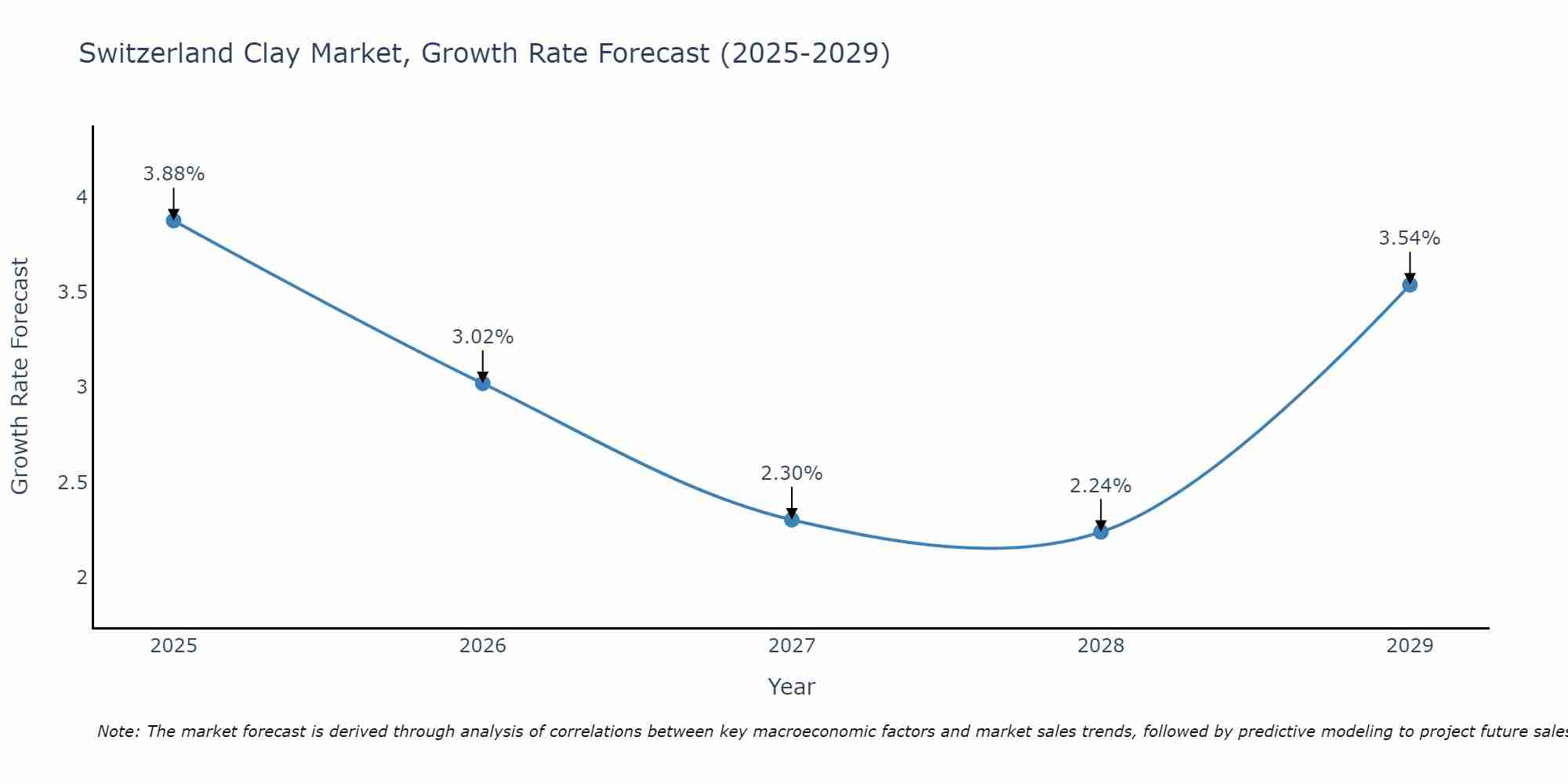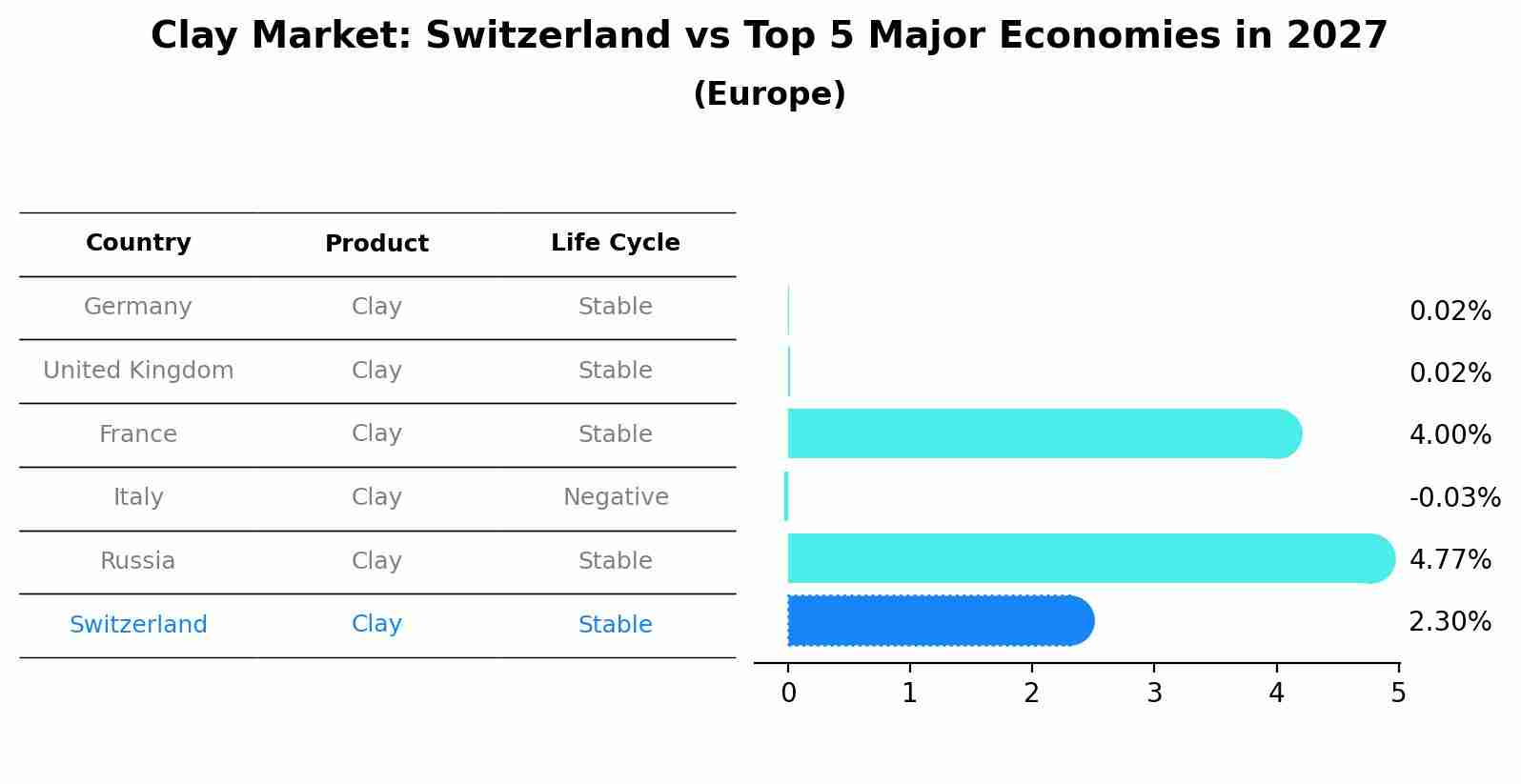Switzerland Clay Market (2025-2031) | Revenue, Industry, Analysis, Companies, Segmentation, Outlook, Value, Growth, Share, Size, Trends & Forecast
| Product Code: ETC5257732 | Publication Date: Nov 2023 | Updated Date: Aug 2025 | Product Type: Market Research Report | |
| Publisher: 6Wresearch | Author: Bhawna Singh | No. of Pages: 60 | No. of Figures: 30 | No. of Tables: 5 |
Switzerland Clay Market Size Growth Rate
The Switzerland Clay Market is projected to witness mixed growth rate patterns during 2025 to 2029. Beginning strongly at 3.88% in 2025, growth softens to 3.54% in 2029.

Clay Market: Switzerland vs Top 5 Major Economies in 2027 (Europe)
By 2027, the Clay market in Switzerland is anticipated to reach a growth rate of 2.30%, as part of an increasingly competitive Europe region, where Germany remains at the forefront, supported by United Kingdom, France, Italy and Russia, driving innovations and market adoption across sectors.

Switzerland Clay Market Overview
The clay market in Switzerland is diversified, encompassing various applications ranging from ceramics and pottery to construction materials and industrial uses. The demand for clay is driven by its versatility and essential role in numerous industries. The construction sector is a significant consumer, utilizing clay for bricks, tiles, and other building materials. Moreover, the rising interest in sustainable and eco-friendly materials is promoting the use of natural clays in various applications. The Swiss market benefits from high-quality clay deposits and advanced processing technologies, ensuring a steady supply of products that meet industry standards.
Drivers of the market
The clay market in Switzerland is influenced by the increasing applications of clay in various industries, including ceramics, construction, and cosmetics. The rising demand for high-quality ceramics, driven by the growing interest in home décor and craftsmanship, is a significant driver of market growth. Additionally, the expanding construction industry, which utilizes clay for bricks and tiles, contributes to the demand. The cosmetic sector`s interest in natural and organic products has also led to increased utilization of clay in skincare and beauty formulations, further boosting the market.
Challenges of the market
The clay market in Switzerland encounters challenges related to environmental regulations and sustainable sourcing practices. The extraction of clay can have significant environmental impacts, leading to stricter regulations that limit production capabilities. Moreover, the demand for eco-friendly products is rising, pushing manufacturers to adopt sustainable practices, which can increase operational costs. The market is also affected by fluctuations in construction and ceramics demand, leading to variability in sales and profitability.
Government Policy of the market
The clay market in Switzerland is shaped by the demand for various clay products in industries such as construction, ceramics, and art. Swiss regulations emphasize quality and environmental sustainability, with strict controls over the extraction and processing of clay. The government promotes sustainable practices in mining and processing, encouraging the use of recycled materials and eco-friendly production methods. This focus on sustainability is essential for preserving Switzerlands natural landscapes while supporting the economic viability of the clay industry.
Key Highlights of the Report:
- Switzerland Clay Market Outlook
- Market Size of Switzerland Clay Market, 2024
- Forecast of Switzerland Clay Market, 2031
- Historical Data and Forecast of Switzerland Clay Revenues & Volume for the Period 2021-2031
- Switzerland Clay Market Trend Evolution
- Switzerland Clay Market Drivers and Challenges
- Switzerland Clay Price Trends
- Switzerland Clay Porter`s Five Forces
- Switzerland Clay Industry Life Cycle
- Historical Data and Forecast of Switzerland Clay Market Revenues & Volume By Application for the Period 2021-2031
- Historical Data and Forecast of Switzerland Clay Market Revenues & Volume By Tableware for the Period 2021-2031
- Historical Data and Forecast of Switzerland Clay Market Revenues & Volume By Sanitary ware for the Period 2021-2031
- Historical Data and Forecast of Switzerland Clay Market Revenues & Volume By Medical applications for the Period 2021-2031
- Historical Data and Forecast of Switzerland Clay Market Revenues & Volume By End Use for the Period 2021-2031
- Historical Data and Forecast of Switzerland Clay Market Revenues & Volume By Ceramic and for the Period 2021-2031
- Historical Data and Forecast of Switzerland Clay Market Revenues & Volume By Non-ceramic for the Period 2021-2031
- Switzerland Clay Import Export Trade Statistics
- Market Opportunity Assessment By Application
- Market Opportunity Assessment By End Use
- Switzerland Clay Top Companies Market Share
- Switzerland Clay Competitive Benchmarking By Technical and Operational Parameters
- Switzerland Clay Company Profiles
- Switzerland Clay Key Strategic Recommendations
Frequently Asked Questions About the Market Study (FAQs):
1 Executive Summary |
2 Introduction |
2.1 Key Highlights of the Report |
2.2 Report Description |
2.3 Market Scope & Segmentation |
2.4 Research Methodology |
2.5 Assumptions |
3 Switzerland Clay Market Overview |
3.1 Switzerland Country Macro Economic Indicators |
3.2 Switzerland Clay Market Revenues & Volume, 2021 & 2031F |
3.3 Switzerland Clay Market - Industry Life Cycle |
3.4 Switzerland Clay Market - Porter's Five Forces |
3.5 Switzerland Clay Market Revenues & Volume Share, By Application, 2021 & 2031F |
3.6 Switzerland Clay Market Revenues & Volume Share, By End Use, 2021 & 2031F |
4 Switzerland Clay Market Dynamics |
4.1 Impact Analysis |
4.2 Market Drivers |
4.2.1 Increasing demand for eco-friendly and sustainable construction materials |
4.2.2 Growing infrastructure development projects in Switzerland |
4.2.3 Rising emphasis on energy-efficient and high-performance building materials |
4.3 Market Restraints |
4.3.1 High competition from alternative construction materials |
4.3.2 Fluctuating raw material prices |
4.3.3 Stringent regulations and standards in the construction industry |
5 Switzerland Clay Market Trends |
6 Switzerland Clay Market Segmentations |
6.1 Switzerland Clay Market, By Application |
6.1.1 Overview and Analysis |
6.1.2 Switzerland Clay Market Revenues & Volume, By Tableware, 2021-2031F |
6.1.3 Switzerland Clay Market Revenues & Volume, By Sanitary ware, 2021-2031F |
6.1.4 Switzerland Clay Market Revenues & Volume, By Medical applications, 2021-2031F |
6.2 Switzerland Clay Market, By End Use |
6.2.1 Overview and Analysis |
6.2.2 Switzerland Clay Market Revenues & Volume, By Ceramic and, 2021-2031F |
6.2.3 Switzerland Clay Market Revenues & Volume, By Non-ceramic, 2021-2031F |
7 Switzerland Clay Market Import-Export Trade Statistics |
7.1 Switzerland Clay Market Export to Major Countries |
7.2 Switzerland Clay Market Imports from Major Countries |
8 Switzerland Clay Market Key Performance Indicators |
8.1 Adoption rate of sustainable construction practices in Switzerland |
8.2 Government investment in infrastructure projects |
8.3 Innovation rate in the clay manufacturing industry |
8.4 Consumer perception and awareness of clay as a viable construction material |
8.5 Rate of adoption of energy-efficient building materials in the market |
9 Switzerland Clay Market - Opportunity Assessment |
9.1 Switzerland Clay Market Opportunity Assessment, By Application, 2021 & 2031F |
9.2 Switzerland Clay Market Opportunity Assessment, By End Use, 2021 & 2031F |
10 Switzerland Clay Market - Competitive Landscape |
10.1 Switzerland Clay Market Revenue Share, By Companies, 2024 |
10.2 Switzerland Clay Market Competitive Benchmarking, By Operating and Technical Parameters |
11 Company Profiles |
12 Recommendations | 13 Disclaimer |
- Single User License$ 1,995
- Department License$ 2,400
- Site License$ 3,120
- Global License$ 3,795
Search
Related Reports
- ASEAN and Thailand Brain Health Supplements Market (2025-2031) | Strategy, Consumer Insights, Analysis, Investment Trends, Opportunities, Growth, Size, Share, Industry, Revenue, Segments, Value, Segmentation, Supply, Forecast, Restraints, Outlook, Competition, Drivers, Trends, Demand, Pricing Analysis, Competitive, Strategic Insights, Companies, Challenges
- ASEAN Bearings Market (2025-2031) | Strategy, Consumer Insights, Analysis, Investment Trends, Opportunities, Growth, Size, Share, Industry, Revenue, Segments, Value, Segmentation, Supply, Forecast, Restraints, Outlook, Competition, Drivers, Trends, Demand, Pricing Analysis, Competitive, Strategic Insights, Companies, Challenges
- Europe Flooring Market (2025-2031) | Outlook, Share, Industry, Trends, Forecast, Companies, Revenue, Size, Analysis, Growth & Value
- Saudi Arabia Manlift Market (2025-2031) | Outlook, Size, Growth, Trends, Companies, Industry, Revenue, Value, Share, Forecast & Analysis
- Uganda Excavator, Crane, and Wheel Loaders Market (2025-2031) | Strategy, Consumer Insights, Analysis, Investment Trends, Opportunities, Growth, Size, Share, Industry, Revenue, Segments, Value, Segmentation, Supply, Forecast, Restraints, Outlook, Competition, Drivers, Trends, Demand, Pricing Analysis, Competitive, Strategic Insights, Companies, Challenges
- Rwanda Excavator, Crane, and Wheel Loaders Market (2025-2031) | Strategy, Consumer Insights, Analysis, Investment Trends, Opportunities, Growth, Size, Share, Industry, Revenue, Segments, Value, Segmentation, Supply, Forecast, Restraints, Outlook, Competition, Drivers, Trends, Demand, Pricing Analysis, Competitive, Strategic Insights, Companies, Challenges
- Kenya Excavator, Crane, and Wheel Loaders Market (2025-2031) | Strategy, Consumer Insights, Analysis, Investment Trends, Opportunities, Growth, Size, Share, Industry, Revenue, Segments, Value, Segmentation, Supply, Forecast, Restraints, Outlook, Competition, Drivers, Trends, Demand, Pricing Analysis, Competitive, Strategic Insights, Companies, Challenges
- Angola Excavator, Crane, and Wheel Loaders Market (2025-2031) | Strategy, Consumer Insights, Analysis, Investment Trends, Opportunities, Growth, Size, Share, Industry, Revenue, Segments, Value, Segmentation, Supply, Forecast, Restraints, Outlook, Competition, Drivers, Trends, Demand, Pricing Analysis, Competitive, Strategic Insights, Companies, Challenges
- Israel Intelligent Transport System Market (2025-2031) | Strategy, Consumer Insights, Analysis, Investment Trends, Opportunities, Growth, Size, Share, Industry, Revenue, Segments, Value, Segmentation, Supply, Forecast, Restraints, Outlook, Competition, Drivers, Trends, Demand, Pricing Analysis, Competitive, Strategic Insights, Companies, Challenges
- Uganda Precast and Aggregate Market (2025-2031) | Strategy, Consumer Insights, Analysis, Investment Trends, Opportunities, Growth, Size, Share, Industry, Revenue, Segments, Value, Segmentation, Supply, Forecast, Restraints, Outlook, Competition, Drivers, Trends, Demand, Pricing Analysis, Competitive, Strategic Insights, Companies, Challenges
Industry Events and Analyst Meet
Our Clients
Whitepaper
- Middle East & Africa Commercial Security Market Click here to view more.
- Middle East & Africa Fire Safety Systems & Equipment Market Click here to view more.
- GCC Drone Market Click here to view more.
- Middle East Lighting Fixture Market Click here to view more.
- GCC Physical & Perimeter Security Market Click here to view more.
6WResearch In News
- Doha a strategic location for EV manufacturing hub: IPA Qatar
- Demand for luxury TVs surging in the GCC, says Samsung
- Empowering Growth: The Thriving Journey of Bangladesh’s Cable Industry
- Demand for luxury TVs surging in the GCC, says Samsung
- Video call with a traditional healer? Once unthinkable, it’s now common in South Africa
- Intelligent Buildings To Smooth GCC’s Path To Net Zero













